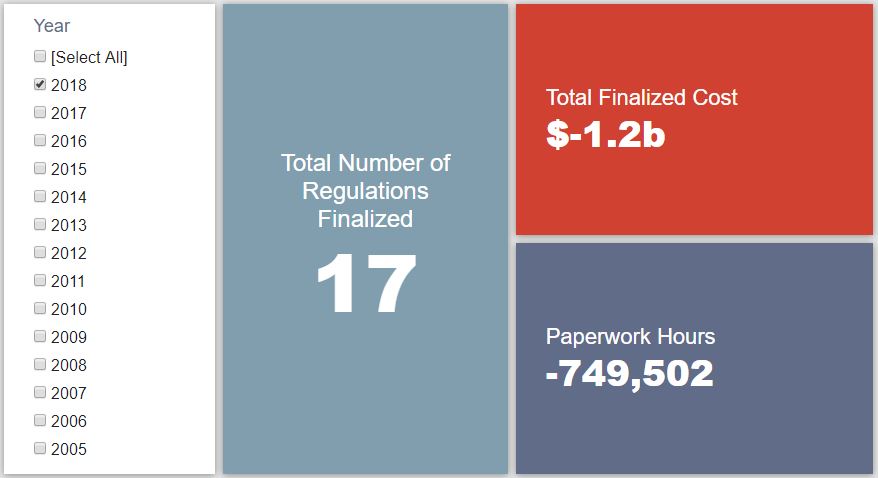Week in Regulation
January 29, 2018
Finalized Cuts Mix With Proposed Burdens
Despite the brief government shutdown to begin the week, agencies were surprisingly active on both the regulatory and deregulatory fronts last week. The Department of Justice (DOJ) saw the largest reduction, while the Department of Health & Human Services (HHS) put forth a costly proposed rule. All together, agencies published 10 rulemakings with quantified economic estimates. These actions could bring $27 million in net regulatory costs and more than 2.2 million hours of new paperwork. The per capita regulatory burden for 2018 is negative $3.83.
Regulatory Toplines
- New Proposed Rules: 30
- New Final Rules: 67
- 2018 Total Pages of Regulation: 3,754
- 2018 Final Rules: -$1.2 Billion
- 2018 Proposed Rules: $880 Million
This past week saw one of the costlier rulemakings under the Trump administration thus far: an HHS proposed rule regarding “Protecting Statutory Conscience Rights in Health Care.” The proposal delegates further authority to the HHS Office for Civil Rights with aim of reinforcing “conscience-based protections for individuals and entities with objections to certain activities based on religious belief and moral convictions.” Notwithstanding the social and cultural implications of this policy, it also establishes further recordkeeping and reporting requirements that could impose more that $814 million in total costs ($168 million annually) and nearly 2.2 million annual paperwork burden hours.
Tracking Regulatory Modernization
The most notable deregulatory action of the week was a DOJ rule implementing part of the “Comprehensive Addiction and Recovery Act (CARA).” Building upon past HHS actions under CARA, the rule would relieve certain restrictions on health practitioners that prescribe drugs for the treatment and detoxification of opioid addiction. The agency estimates that this action could produce $808 million in total net cost reductions ($156 million annually).
There was also an interim final rule expected to produce cost savings under Executive Order (EO) 13,771. The inter-agency rule (led by HHS) would provide a 6-month delay in the effective date for a January 2017 rule regarding the “Federal Policy for the Protection of Human Subjects.” The original rule – one of the last significant rules published under the Obama administration – brought $67 million in annual costs. This delay provides $6.9 million in annualized savings.
According to American Action Forum (AAF) analysis, since the start of FY 2018 (beginning Oct. 1, 2017), executive agencies have promulgated 16 deregulatory actions with quantified cost savings against 5 regulatory measures that impose costs, under the rubric created by EO 13,771 and the administration’s subsequent guidance document on the matter. These rules combine for a net annual savings of roughly $609.4 million. The administration’s goal for FY 2018 is $687 million in net annual savings.
Click here to view AAF’s examination of the administration’s progress under the “one-in, two-out” executive order through the end of Fiscal Year 2017.
State of Major Obama-Era Initiatives
Based on total lifetime costs of the regulations, the Affordable Care Act has imposed costs of $53 billion in final state and private-sector burdens and 176.9 million annual paperwork hours.
Since passage, the Dodd-Frank financial reform legislation has produced more than 82.9 million final paperwork burden hours and imposed $38.9 billion in direct compliance costs.
Total Burdens
Since January 1, the federal government has published $357.1 million in net costs savings ($1.2 billion from final rules) and new paperwork burdens amounting to 1.4 million hours (however, this includes 749,502 hours cut under final rules). Click below for the latest Reg Rodeo findings.











